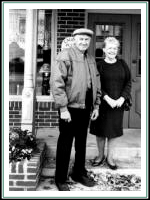Near downtown in the Village of
Dundee, a dam had been constructed on the River Raisin in the
early 1800s.
A building containing a grist mill was built on the east side of
the river In 1910. It was converted to the Dundee Hydraulic
Power Company but Detroit Edison soon came into the area and ran
them out of business. Then in 1935, Henry Ford purchased the
facility and began to use it for making manufactured goods.
 After Ford died, Ford Motor Company decided to sell all these
little factories scattered around the state. The property was
eventually purchased in 1954 by Wolverine
Manufacturing Company of Dearborn, Michigan.
After Ford died, Ford Motor Company decided to sell all these
little factories scattered around the state. The property was
eventually purchased in 1954 by Wolverine
Manufacturing Company of Dearborn, Michigan.
In 1970, the building was
sold to the Village of Dundee for $1.00 and it became the
Old Mill Museum.
Walter and Madelyn (Hanson) Berns were quite active working with
this volunteer organization.
Part of the facility became
the Old Mill Hall Banquet Room and the
Heiden Family Reunion was held there
on September 3, 1995 and August 27, 2000.

 Even though it was no yet a
widely used concept, Wolverine was an early entry into the recycling
arena. At the Old Mill site, they took bales of used or outdated envelopes and other paper
products and turned them into gasket material for the auto
industry. My father,
Art Heiden worked there briefly and my
uncle,
William Frank Heiden
(right)
worked there for several years.
Even though it was no yet a
widely used concept, Wolverine was an early entry into the recycling
arena. At the Old Mill site, they took bales of used or outdated envelopes and other paper
products and turned them into gasket material for the auto
industry. My father,
Art Heiden worked there briefly and my
uncle,
William Frank Heiden
(right)
worked there for several years.
During two summer college
vacations and one Christmas break in the late 1960s, I worked at Wolverine with my
uncle and 4 or 5 other employees. One summer I worked the 3:30 pm
to midnight shift and really liked it...for one summer anyway.
The UAW wages were very nice compared to the money I earned
another summer working 70 hours per week at the
Texaco gas
station in town.

